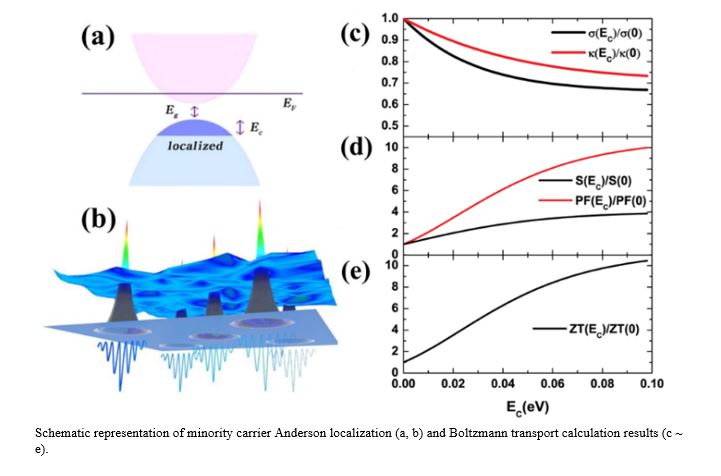Video Article Open Access
Synergetic Enhancement of Thermoelectric Performance by Selective Charge Anderson Transition and Topological Phase Transition
Jong-Soo Rhyee
Department of Applied Physics and Institute of Natural Sciences, Kyung Hee University, Yong-In 17104, Korea
Vid. Proc. Adv. Mater., Volume 1, Article ID 2020-0833 (2020)
DOI: 10.5185/vpoam.2020.0833
Publication Date (Web): 03 Nov 2020
Copyright © IAAM
Graphical Abstract

Abstract
Considerable efforts have been devoted to enhancing thermoelectric (TE) performance, by employing phonon scattering from nano-structural architecture, and material design using phonon-glass and electron-crystal concepts. The nanostructural approach helps to lower thermal conductivity but has limited effect on the power factor. Here, we demonstrate selective charge Anderson localization as a route to maximize the Seebeck coefficient while simultaneously preserving high electrical conductivity and lowering the lattice thermal conductivity. We confirm the viability of interface potential modification in an n-type Bi-doped PbTe/Ag2Te nanocomposite, and the resulting enhancement in thermoelectric figure-of-merit ZT. The introduction of random potentials via Ag2Te nanoparticle distribution using extrinsic phase mixing was determined using scanning tunneling spectroscopy measurements. When the Ag2Te undergoes a structural phase transition (T > 420 K) from monoclinic β-Ag2Te to cubic α-Ag2Te, the band gap in the α-Ag2Te increases due to the p-d hybridization. This results in a decrease in the potential barrier height, which gives rise to partial delocalization of the electrons, while wave packets of the holes are still in a localized state. Using this strategic approach, we achieved an exceptionally high thermoelectric figure-of-merit in n-type PbTe materials, a ZT greater than 2.0, suitable for waste heat power generation.
References
- Min Ho Lee and Jong-Soo Rhyee et al., ACS Nano DOI: 10.1021/acsnano.8b08579.
- Y. Imry and A. Amir, in 50 Years of Anderson Localization, ed. E. Abrahams, World Scientific, Singapore. 2011, Ch. 9, 191-212.
Biography
Jong-Soo Rhyee, Department of Applied Physics and Institute of Natural Sciences, Kyung Hee University, Yong-In 17104, Korea
Education:
- Ph.D, Dept. of Materials Science and Engineering, Gwangju Institute of Science and Technology (GIST)
- M.S., Dept. of Physics, Pohang University of Science and Technology (POSTECH)
- B.S., Dept. of Physics, Chungbuk National University
Honors and Awards:
- IAAM Scientist Medal, International Association of Advanced Materials (February 5, 2018)
- 2017 Outstanding Achievement in Research, Kyung Hee University (2017)
- Overseas Research Professor Fellowship, SBS Cultural Foundation (January 2015 ~ December 2015)
- TJ Park Junior Faculty Fellowship, POSCO TJ Park Foundation (October 2011 ~ September 2013)
- Bombi Physics Award, April meeting on Korean Physical Society (April 21, 2010)
- World Best Paper Award, by SAIT President Sang-wan Lee (October 22, 2009)
- Young Investigator Award, by International Thermoelectric Society (ICT2009/ECT2009 joint conference, 30th July 2009, Freiburg, Germany)
Research Interests:
- Thermoelectric materials (Chalcogenides and new materials)
- Topological materials such as Dirac and Weyl semimetals
- Unconventional superconductivity and magnetism
Representative Publications: (Published 118 SCI papers)
- Jong-Soo Rhyee et. al., Nature 459, 965-968 (2009).
- Jong-Soo Rhyee et. al., Advanced Materials 23, 2191-2194 (2011).
- Jong-Soo Rhyee et. al., Advanced Materials 28, 2316-2321 (2016).
- Dianta Ginting and Jong-Soo Rhyee et. al., Journal of Materials Chemistry A 6, 5870-5879 (2018)
- Chan-Chieh Lin and Jong-Soo Rhyee et. al., ACS Applied Materials & Interfaces 10, 10927-10934 (2018)
- Min Ho Lee and Jong-Soo Rhyee et. al., ACS Nano 13, 3806-3815 (2019)
Video Proceedings of Advanced Materials

Upcoming Congress



